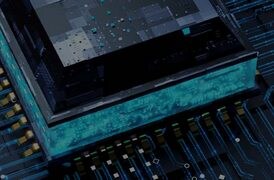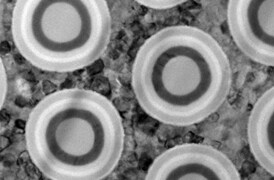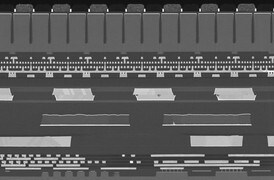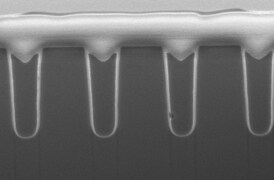Search Thermo Fisher Scientific

ELECTRICAL FAILURE ANALYSIS SYSTEMS
nProber IV System
Nanoprobing for electrical fault isolation and efficient TEM workflows to improve semiconductor failure analysis.
Join the Conversation
The Thermo Scientific nProber IV System is a high-performance scanning-electron-microscopy-based platform for the localization of transistor and metallization faults. It is our most advanced nanoprobing system to date, and the first to use the high-resolution LEEN2 SEM Column. The nProber IV System is specifically designed to increase the speed, accuracy, and output of your failure analysis (FA) workflow, where productivity is paramount.
The nProber IV System directly increases the success rate of transmission electron microscopy (TEM) analysis through precise fault localization and has proven to be both accurate and repeatable on even the most challenging process nodes. The automation and guided workflows of the nProber IV System improve lab productivity and allow your organization to focus on the output of your nanoprobing and TEM workflows while investing less in the operation of the system itself, thereby accelerating time-to-yield.
Improved process yield ramp with the nProber IV System
Time to yield is a significant focus for semiconductor fabs. The key to faster time to yield is the efficient identification of critical defects during process and device development. Nanoprobing plays a vital role in process yield ramp, localizing faults that cannot be found with other failure analysis techniques. Nanoprobing also delivers the precise localization required to ensure that the thin TEM samples will fully contain the fault, greatly improving the success rate of your TEM workflow. Finally, as nanoprobing localizes faults through accurate electrical characterization, TEM workflows that utilize nanoprobing combine TEM physical failure analysis with electrical fault signatures, helping to correlate process control improvements with device performance.
Thermo Fisher Scientific is the leader in supplying TEM workflows for process and device yield ramp, with widely adopted solutions for nanoprobing sample preparation, nanoprobing, TEM sample preparation and TEM physical failure analysis.
Leading edge transistor probing
nProber IV SteadFast Nanomanipulators and temperature-controlled probing environment combine to give the probe the necessary stability for working with leading-edge transistors.
High-resolution imaging of sensitive samples
The new LEEN2 Column of the nProber IV System enables low eV imaging and probing operation and includes an advanced control system that reduces sample dose by up to 30%. These advances allow the nProber IV System to provide accurate measurements of critical transistor parameters with minimal shifts from SEM imaging.
Guided operation and automation
The nProber IV System is equipped with eFast semi-automated guided workflows that take you through system operation from sample loading to electrical characterization. eFast Software automates the setup of the LEEN2 Column and controls key sub-systems ensuring consistent results in a multi-user production environment.
3D structures
The nProber IV Systems can be equipped with EBIRCH2 and EBAC to find critical faults in 3D interconnect structures down to ~100 Ω. EBIRCH2 can also be used to localize critical defects in FinFET transistors.
In addition, the nProber IV System can be equipped with a sub-stage that enables probes to be separated by many millimeters, essential for the isolation of faults in large 3D NAND structures.
Resistive gate faults
The nProber IV Systems can isolate resistive gate faults utilizing high-speed pulsed probing with rise times of less than 1 ns.
Automation
Our easyProbe Software automates key steps in the nProber IV workflow including: cleaning the probes, lowering the probes to the sample, and optimizing the electrical contact between the probes and the sample. easyProbe Software significantly reduces the training required to use the nProber IV System and allows for extended periods of unattended operation.
Automotive reliability
The optional Thermal Characterization Package supports the most recent automotive reliability standards. Samples temperatures can be controlled from -40°C to 150°C in order to isolate faults that are not detectable at ambient temperatures.

Semiconductor Device Packaging
Advanced semiconductor device packaging requires new integration approaches and innovation in performance, power efficiency, area, and cost. See how Thermo Scientific failure analysis workflows provide fast, precise, and accurate time-to-data for device packaging development.

Semiconductor Pathfinding and Research
Advanced electron microscopy, focused ion beam, and associated analytical techniques for identifying viable solutions and design methods for the fabrication of high-performance semiconductor devices.

Semiconductor Failure Analysis
Increasingly complex semiconductor device structures result in more places for failure-inducing defects to hide. Our next-generation workflows help you localize and characterize subtle electrical issues that affect yield, performance, and reliability.

Physical and Chemical Characterization
Ongoing consumer demand drives the creation of smaller, faster, and cheaper electronic devices. Their production relies on high-productivity instruments and workflows that image, analyze, and characterize a broad range of semiconductor and display devices.

Power Semiconductor Device Analysis
Power devices pose unique challenges for localizing faults, primarily as a result of power device architecture and layout. Our power device analysis tools and workflows quickly pinpoint fault locations at operating conditions and provide precise, high-throughput analysis for characterization of materials, interfaces and device structures.
Nanoprobing
As device complexity increases, so does the number of places defects have to hide. Nanoprobing provides the precise localization of electrical faults, which is critical for an effective transmission electron microscopy failure analysis workflow.
Sample Preparation of Semiconductor Devices
Thermo Scientific DualBeam systems provide accurate TEM sample preparation for atomic-scale analysis of semiconductor devices. Automation and advanced machine learning technologies produce high-quality samples, at the correct location, and a low cost per sample.
Device Delayering
Shrinking feature size, along with advanced design and architecture, results in increasingly challenging failure analysis for semiconductors. Damage-free delayering of devices is a critical technique for the detection of buried electrical faults and failures.
Nanoprobing
As device complexity increases, so does the number of places defects have to hide. Nanoprobing provides the precise localization of electrical faults, which is critical for an effective transmission electron microscopy failure analysis workflow.
Sample Preparation of Semiconductor Devices
Thermo Scientific DualBeam systems provide accurate TEM sample preparation for atomic-scale analysis of semiconductor devices. Automation and advanced machine learning technologies produce high-quality samples, at the correct location, and a low cost per sample.
Device Delayering
Shrinking feature size, along with advanced design and architecture, results in increasingly challenging failure analysis for semiconductors. Damage-free delayering of devices is a critical technique for the detection of buried electrical faults and failures.
Electron microscopy services
To ensure optimal system performance, we provide you access to a world-class network of field service experts, technical support, and certified spare parts.